美国教育制度英文
- 格式:doc
- 大小:73.05 KB
- 文档页数:8
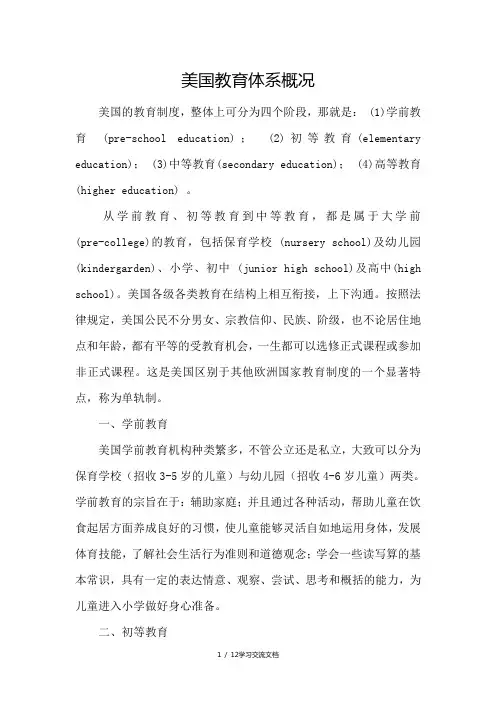

美国的教育制度:美国的教育制度,整体上可分为四个阶段,那就是:(i)学前教育(pre-school education);(ii)初等教育(elementary education);(iii)中等教育(secondary education);(iv)高等教育(higher education) 。
从学前教育、初等教育到中等教育,都是属于大学前(pre-college)的教育,包括保育学校(nursery school)及幼儿园(kindergarden)、小学、初中(junior high school)及高中(high school)。
1. 美国大学的学位(一)硕士学位(Master' Degree ):视乎学科的性质来决定是文科硕士(M.A.)或理科硕士(M.S.) ,通常需时两年的时间;亦有一些学校设有公共行政学硕士(Master of Public Administration)、法学硕士(Master of Law)、神学硕士(Master of Divinity)等学位课程。
(二) 工商管理学硕士(M.B.A. 即Master of Business Administration):由于近年的工商发展迅速,对工商管理人材的需求殷切,为配合市场的需要,攻读M.B.A.学位的人士日渐增多甚至留学生念这课程的人数也急速上升,以满足中国大陆、香港、台湾三地市场经济发展上的需要。
(三) 博士学位(Doctoral Degree):博士学位课程通常是需要先修毕硕士课程,但亦有例外。
最普遍的博士学位就是哲学博士(Ph.D.,即Doctor in Philosophy),但绝大部分的文、理科博士大都是授予Ph.D.学位,而不单限于哲学这个学科。
通常博士学位课程需要三年或以上的时间,理科时间较短,文科时间大多较长。
博士学位则称为Ed.D.(Doctor in Education)。
(四)法学博士(J.D.)与医学博士(M.D.):这是美国社会的律师与医生必须具备的专业学位。
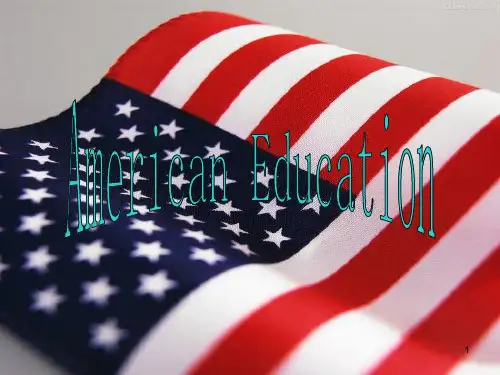


美国教育介绍_完整英文版The Education System in the United StatesElementary education in the United States typically begins with kindergarten, which is the first year of formal schooling. Kindergarten is a half-day program that focuses on developing basic academic skills, such as reading, writing, and math, aswell as social and emotional skills. After kindergarten,students progress through five more years of elementary school, covering grades one through five. Elementary school curriculumis designed to provide a well-rounded education, including subjects such as English, math, science, and social studies, as well as physical education and the arts.The U.S. education system is known for its emphasis on individualism and creativity. Students are encouraged to think critically, solve problems, and express their ideas and opinions. The system also promotes diversity and inclusivity, with efforts to provide equal access to education for students of all backgrounds.However, it is important to note that the U.S. education system also faces challenges and disparities. There aresignificant gaps in academic achievement between different demographic groups, and funding for schools varies widely across different states and districts. Efforts are being made toaddress these issues and improve the overall quality of education in the United States.。
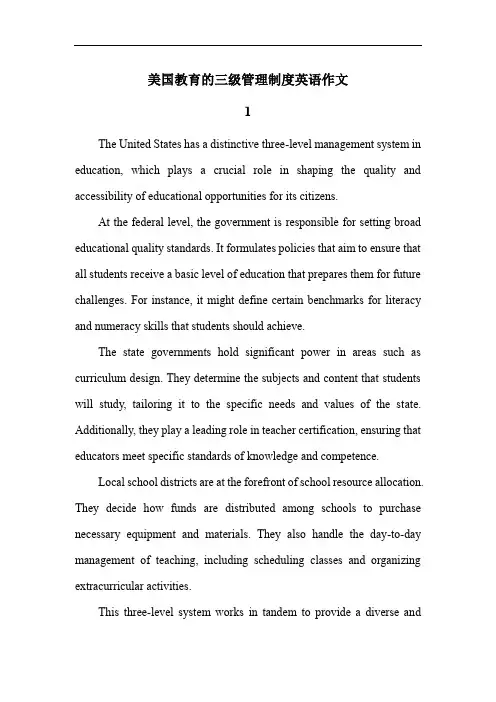
美国教育的三级管理制度英语作文1The United States has a distinctive three-level management system in education, which plays a crucial role in shaping the quality and accessibility of educational opportunities for its citizens.At the federal level, the government is responsible for setting broad educational quality standards. It formulates policies that aim to ensure that all students receive a basic level of education that prepares them for future challenges. For instance, it might define certain benchmarks for literacy and numeracy skills that students should achieve.The state governments hold significant power in areas such as curriculum design. They determine the subjects and content that students will study, tailoring it to the specific needs and values of the state. Additionally, they play a leading role in teacher certification, ensuring that educators meet specific standards of knowledge and competence.Local school districts are at the forefront of school resource allocation. They decide how funds are distributed among schools to purchase necessary equipment and materials. They also handle the day-to-day management of teaching, including scheduling classes and organizing extracurricular activities.This three-level system works in tandem to provide a diverse andcomprehensive educational experience. Each level has its unique responsibilities and contributions, collectively striving to offer quality education that meets the diverse needs of students across the nation. The collaboration and balance among the federal, state, and local levels are essential for the continuous improvement and success of the American educational system.2The three-level management system of education in the United States plays a crucial role in shaping the educational landscape of the country. At the federal level, the government provides substantial financial support, which has significantly contributed to promoting educational equity. For instance, it funds educational programs for disadvantaged students, ensuring they have access to quality education. However, there might be inconsistencies in the implementation of policies across different states.The state governments, on the other hand, enjoy flexibility in formulating policies to meet the specific needs of their localities. This adaptability allows for customization based on regional characteristics and priorities. However, it could potentially lead to significant differences in educational standards and opportunities among different states.The local school districts have direct management over educational institutions within their boundaries. They are better positioned to understand and address the needs of the local community. But the resourceallocation could be imbalanced, with some districts having abundant resources while others struggle to meet basic requirements.In conclusion, the three-level management system of education in the United States has its strengths and challenges. A balanced and coordinated approach among the federal, state, and local authorities is essential to optimize the educational system and provide quality education for all students.3The educational management system in the United States is characterized by a three-level administrative structure, which sets it apart from many other countries. In contrast to the centralized educational management model in some European countries, the United States grants more autonomy to states and local communities. For instance, in certain European nations, educational policies and curricula are often dictated by the central government, leaving little room for local variations and adaptations. However, in the United States, states have the authority to formulate their own educational standards and curricula, based on the specific needs and circumstances of their regions.When compared to some Asian countries where local autonomy is relatively limited, the American system provides greater flexibility and innovation at the local level. In these Asian countries, educational decisions are often made at the national level, and local authorities have less say inshaping educational programs. In the United States, local school districts can make decisions regarding teaching methods, resource allocation, and even the selection of textbooks, which allows for a more tailored educational experience for students.This decentralized approach in the United States has both advantages and challenges. On the one hand, it encourages diversity and experimentation, enabling different regions to develop educational models that suit their unique demographics and cultural contexts. It also promotes community engagement and accountability, as local stakeholders have a direct influence on the quality of education. On the other hand, it can lead to disparities in educational quality between different states and districts, as resources and capabilities vary.Overall, the three-level management system of education in the United States offers a distinct framework that emphasizes local autonomy and flexibility, while also presenting ongoing opportunities for improvement and balance to ensure equal educational opportunities for all students.4The three-level management system of education in the United States plays a crucial role in shaping the educational landscape and influencing the learning outcomes and quality of education for students. This system, which typically consists of federal, state, and local levels, has both positiveand negative impacts.In some areas where the system functions effectively, students have witnessed remarkable improvements in their academic achievements. For instance, in states with well-defined educational policies and adequate resource allocation at the state and local levels, schools are equipped with modern facilities and highly qualified teachers. This leads to students having access to a rich and diverse curriculum, and as a result, they perform exceptionally well in standardized tests and are well-prepared for higher education and future careers.However, in other regions where management is not as efficient, the quality of education varies significantly. Insufficient funding at the local level may result in outdated textbooks and limited extracurricular activities. Moreover, a lack of coherent policies between the federal and state levels can cause confusion among educators and hinder the implementation of effective teaching methods. This can have a detrimental effect on students' learning experiences and overall educational attainment.In conclusion, the three-level management system of education in the United States has the potential to provide high-quality education when properly coordinated and implemented. However, it also poses challenges that need to be addressed to ensure that all students receive a fair and excellent education regardless of their geographical location.5The three-level management system of education in the United States has long been an important framework shaping the educational landscape. However, as technology continues to advance and social needs evolve, significant changes are likely on the horizon.One notable trend could be a greater emphasis on personalized education. With the aid of advanced analytics and artificial intelligence, educational institutions may be able to tailor curricula and learning paths to the unique strengths and weaknesses of each student. This would not only enhance learning outcomes but also foster a more engaged and motivated student body.Another potential development is the seamless integration of online education resources. The digital revolution has opened up a world of educational possibilities, allowing students to access high-quality courses and materials from anywhere. This could lead to a more equitable distribution of educational opportunities, breaking down geographical and economic barriers.Furthermore, there might be a shift towards interdisciplinary learning. In a rapidly changing world, the boundaries between traditional subjects are blurring. Encouraging students to draw connections across various fields of knowledge will better prepare them for the complex challenges of the future.In conclusion, the future of the three-level management system of education in the United States appears promising, with a focus on customization, digitalization, and interdisciplinarity. These changes have the potential to revolutionize education and ensure that students are equipped with the skills and knowledge needed to thrive in the 21st century.。
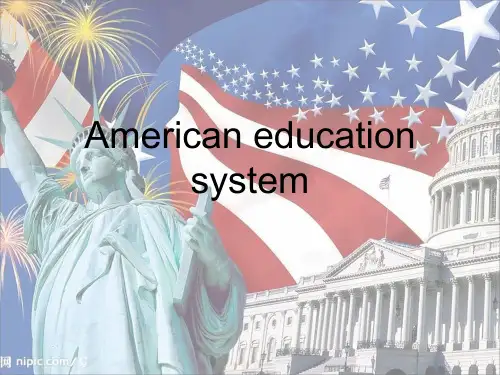

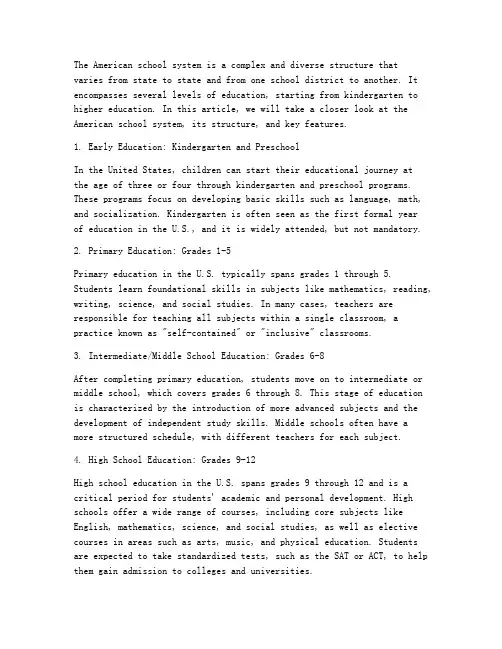
The American school system is a complex and diverse structure thatvaries from state to state and from one school district to another. It encompasses several levels of education, starting from kindergarten to higher education. In this article, we will take a closer look at the American school system, its structure, and key features.1. Early Education: Kindergarten and PreschoolIn the United States, children can start their educational journey atthe age of three or four through kindergarten and preschool programs. These programs focus on developing basic skills such as language, math, and socialization. Kindergarten is often seen as the first formal yearof education in the U.S., and it is widely attended, but not mandatory.2. Primary Education: Grades 1-5Primary education in the U.S. typically spans grades 1 through 5. Students learn foundational skills in subjects like mathematics, reading, writing, science, and social studies. In many cases, teachers are responsible for teaching all subjects within a single classroom, a practice known as "self-contained" or "inclusive" classrooms.3. Intermediate/Middle School Education: Grades 6-8After completing primary education, students move on to intermediate or middle school, which covers grades 6 through 8. This stage of education is characterized by the introduction of more advanced subjects and the development of independent study skills. Middle schools often have a more structured schedule, with different teachers for each subject.4. High School Education: Grades 9-12High school education in the U.S. spans grades 9 through 12 and is a critical period for students' academic and personal development. High schools offer a wide range of courses, including core subjects like English, mathematics, science, and social studies, as well as elective courses in areas such as arts, music, and physical education. Students are expected to take standardized tests, such as the SAT or ACT, to help them gain admission to colleges and universities.5. College and Higher EducationAfter high school, students can pursue higher education at colleges and universities. The U.S. has a diverse range of institutions, from community colleges and technical schools to large research universities. College education typically spans four years and leads to a bachelor's degree. Many students also opt for graduate studies, which can lead to master's and doctoral degrees.Key Features of the American School System:1. Diversity: The U.S. school system is incredibly diverse, with a wide range of educational options available to students.2. Choice: Parents and students have the option to choose schools within their district or even attend schools in other districts through open enrollment or school choice programs.3. Accountability: The American school system emphasizes accountability, with schools and teachers regularly evaluated based on student performance and other factors.4. Private and Public Schools: The U.S. has a mix of private and public schools, with each offering different educational approaches and experiences.5. Special Education: The American school system is designed to accommodate students with disabilities, ensuring they receive the necessary support to succeed academically and socially.In conclusion, the American school system is a complex and dynamic structure that aims to provide students with a well-rounded education. From early childhood to higher education, the system offers a variety of options and opportunities for students to develop their skills and achieve their goals.。

美国教育规章制度英语作文In the United States, education regulations and systems vary from state to state. Each state has its own education department responsible for setting and enforcingeducational standards. These standards cover areas such as curriculum, teacher qualifications, and student assessments.School funding in the United States is primarily the responsibility of the state and local governments. This means that the amount of funding and resources available to schools can vary greatly depending on the location. Some states have higher property taxes, which can result in more funding for schools in those areas.The United States has a system of public education, which is free and available to all students. However, there are also private schools that operate independently and charge tuition. In addition, there are charter schools, which are publicly funded but operate independently of the public school system.Standardized testing is a major part of the education system in the United States. Students are required to take standardized tests at various grade levels to assess their academic progress. These tests are often used to measure school performance and to hold schools and teachers accountable.In recent years, there has been a growing emphasis on the importance of early childhood education in the United States. Many states have implemented programs to provide early education opportunities for young children, with the goal of improving school readiness and academic success.The United States also has laws in place to ensure equal access to education for students with disabilities. The Individuals with Disabilities Education Act (IDEA) guarantees that students with disabilities receive a free and appropriate public education tailored to their individual needs.In conclusion, the education regulations and systems inthe United States are complex and multifaceted, with a focus on standards, funding, diversity of school options, standardized testing, early childhood education, and support for students with disabilities. These factors all contribute to the diverse and dynamic landscape of education in the United States.。
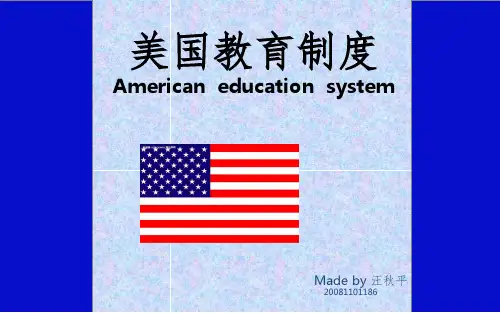
The System of American Education Abstract: Compared with other big powers in the world, the United Sates of America is a very young country in the history of the world. Its education started too late, but whose development is very rapid. In fact, American educational system plays an important role in this situation.Keyword: American; system; educationThe United States is very strong in education and shoulders huge task of education. To discuss education in the United States is a very complicated problem, because it is a multicultural country. American education is also diverse reflecting on the education, there is no unified national education system in the United States and fifty states have 50 different education system. There is no doubt that mang people pay much attention to the system of American education. The major difference in education system between American and most other countries is that the education of the United States is for everyone in society, not only for a few people. American educational system can be best understood as a kind of socialinstitutions that reflect the basic beliefs and fundamental principles of the nation, rather than simply a kind of skill-training places where students are prepared to get a job.[1] All in all, the system of American education has its own special features and attract a lot of countries’attention.I. The History of American educationAs one of the basic contents of social life, education has a close relationship with one nation’s growth. There were many people graduated from Oxford College and Cambridge College between the first English settlers to America in the colonial era of 17th century. It is estimated that there is a college student out of every 40 to 50 families. This immigration of higher education background made them attach great importance to education. And the early immigrants from England needed a kind of culture to help them understand The Bible by themselves because of their devotion to religion. These two factors made the education of America start. Harvard College was founded as early as 1636, only fifteen years after the Pilgrim Fathers had landed in the New World.[2] William Mary university was built in 1639 and Yale university was established in 1701. Before 1776 when America declaredindependence from Great Britain, eight other colleges came into existence.[3] All these indicate that Americans have shown a great concern for education since early colonial times. Between 1825 and 1850, public education was established in America. All states were built basic education system which was open to all children States and without religious discrimination and the basis of economic conditions. Many public universities and colleges also appeared and they enriched the education of America along with a large number of private colleges.II. The S tructure of School SystemThe American education of all types and at all levels join each other in structure and communicate with each other up and down. At any rate, from elementary school through college, Americans hold the belief that everyone deserves a fair and equal opportunity to get a good education, and that part of the responsibility of the government is to make sure that such an opportunity is not denied to any one of them.[4] One of the striking features, differ American education system from other European countries’ education system, call a monorail system. It formed in the second half of the 19th century and can be specifically divided into the bottom-up structure: primary school, secondary school, and then university. "Rail" is thenumber of class in one grade.The current school system of America education also reflects the feature of the combination of unity and diversity. Due to a thorough system of decentralization in education, America has no unified national educational system.The current system of America education is basically fallen into following parts : elementary education and secondary education for 12 years, 4 years of higher education, and graduate school, the total course of 20 years or so. There are many different kinds of preschool education institutions in America. No matter public or private, it can be roughly divided into nursery school (for children aged 3 ~ 5) and the kindergarten (recruit children aged 4 ~ 6); Elementary education is distributed into public education and private education, which pays attention to develop the potential of children; There are mainly four years, six years to construct and three kinds of three-thirds system in secondary school in America. Its main part is the comprehensive school and its minor part are the general education and vocational and technical education. Besides, there are also separate secondary schools, vocational and technical schools, says middle school and other high school; The lessons of higher education colleges and universities inAmerica are divided into four categories: a two-year college (community college) (tertiary), liberal arts college (four-year college), universities and professional schools.[5]III. The Education ManagementAmerican education management implements the high degree of decentralization. In America, the education management is the responsibility of the state or local government, rather than the federal government. As early as in 1791, the 10th amendment of the constitution of America has been defined, the federal government does not have the permission to manage education and education is charged by the states. The powers of the ministry of education in American federal government are very limited, whose main responsibility is to distribute education grants to the states according to the intentions of congress, as well as offer scholarships to American domestic students. The states of America are equipped with the education minister who are in charge of drawing up the state's education policy and lead the subordinate organizations to implement these policies. While according to the state law, all states mostly give the management right of public school to the local school districts, in addition to set up the state board ofeducation and make the basic policy of education’s development. Therefore, the management right of elementary education and secondary education actually belongs to the local school districts and the local public school management system in which the school district plays the leading role ha been established.[6] American universities all have their own characteristics and they are different from the teaching guidelines, professional Settings, test project to small problems such as admission to the TOEFL scores and application fee and so on.IV. The Goals and Purposes of EducationHistorically, the chief aim of education in early times was literacy in order that people might be able to read and write the Bible and laws. When the republic was founded, literacy was still a primary objective, but for the new purpose of fulfilling the obligations of citizenship in the new country. Under the new system, each individual citizen was obligated to vote according to his own opinions and conscience, and to take part in the discussion and decision making at local, state, and national levels. As the nation grew in population and in territory, as its economy expanded, and particularly as the industrial revolution changed the complexity of life andcitizenship, education grew in importance and its goals and purposes became more diverse and comprehensive. If the objectives of education in America were to be reduced to a single sentence, it might be summarized as follows: to facilitate the development of each individual to the maximum extent of his or her capability for his or her own benefit and that of society.[7]The education methods of Western countries are close to nature and more closer to the society. In China, the purpose of education is to pass school exams and have a thorough understanding of knowledge while the western students pay more attention to ability of practice and exercise. The study of American students is mainly to explore and develop students' innovative thinking. The advantage of American education is to pay more attention to the students' ability of independent thinking, their way of thinking to the problem and cultivate students' ability of dialectical thinking.This can prepare well for entering the society which attaches importance to the innovative thinking. Its education goal is adapted to the requirements of creating a society with talent intensive.There is no doubt that the eduction system of China and America is different. The differences are as follows: Firstly,the teaching goal of these two countries’ elementary education is different. China's primary education will develop children’s intelligence and the children takes high marks as a primary goal, while in America, its only purpose is to cultivate children’s creativity; Secondly, the attitudes towards performance are different. For Chinese children, a bad report card will make him or her receive pressure from all sides. However, the year-end report cards of students in America are their own private goods. Parents also won't give too much pressure to their children and abilities in their heart are more important than scores; Lastly, there are differences between the two countries in knowledge view. China's education pays attention to the accumulation of knowledge, cultivate the students' respect for knowledge and authority,the inheritance of knowledge and the construction of knowledge system. America’s education attaches much importance to train students' practical use of knowledge, their critical spirit to the knowledge and authority and the expansion and creation of knowledge. These two different ways of education express their different attitude towards knowledge.[8] All in all, education is a cultural phenomenon, different education reflects different cultural connotations. The education method oreducation system which is suitable for the society of the America maybe not adapt to China's current social education system. what we need is the combination of localization and internationalization of modern education.References1.王恩铭:《美国文化教程》,,复旦大学,2011年4月第1版2.王恩铭:《英语国家概况》,,外语教育3.燕敏:《素质教育在美国》,科学技术,2013年6月4.廖娜:《美国教育史概略》,;广播电视大学学报,2009年第2期(总第51期)5.王英杰:《美国高等教育发展与改革百年回眸》,;高等教育研究,2000年第1期,31-38页6.徐双荣:《美国特许学校面面观》,;教学与管理,2000年9月,73-75页。
Understanding the American Education SystemThe American education system offers a rich field of choices for international students. There is such an array of schools, programs and locations that the choices may overwhelm students, even those from the U.S. As you begin your school search, it’s important to familiarize yourself with the American education system. Understanding the system will help you narrow your choices and develop your education plan.The Educational Structure:PRIMARY AND SECONDARY SCHOOLPrior to higher education, American students attend primary and secondary school for a combined total of 12 years. These years are referred to as the first through twelfth grades.Around age six, U.S. children begin primary school, which is most commonly called “elementary school.” They attend fi ve or six years and then go onto secondary school.Secondary school consists of two programs: the fi rst is “middle school” or “junior high school” and the second program is “high school.” A diploma or certi ficate is awarded upon graduation from high school. After graduating high school (12th grade), U.S. students may go on to college or university. College or university study is known as “higher education.”GRADING SYSTEMJust like American students, you will have to submit your academic transcripts as part of your application for admission to university or college. Academic transcripts are official copies of your academic work. In the U.S. this includes your “grades” and “grade point average” (GPA), which are measurements of your academic achievement. Courses are commonly graded using percentages, which are converted into letter grades.The grading system and GPA in the U.S. can be confusing, especially for international students. The interpretation of grades has a lot of variation. For example, two students who attended different schools both submit their transcripts to the same university. They both have 3.5 GPAs, but one student attended an average high school, while the other attended a prestigious school that was academically challenging. The university might interpret their GPAs differently because the two schools have dramatically different standards.Therefore, there are some crucial things to keep in mind:You should find out the U.S. equivalent of the last level of education you completed in your home country. Pay close attention to the admission requirements of each university and college, as well as individual degree programs, which may have different requirements than the university. Regularly meet with an educational advisor or guidance counselor to make sure you are meeting the requirements.Your educational advisor or guidance counselor will be able to advise you on whether or not you must spend an extra year or two preparing for U.S. university admission. If an internationalstudent entered a U.S. university or college prior to being eligible to attend university in their own country, some countries’ governments and employers may not recognize the students’ U.S. education.ACADEMIC YEARThe school calendar usually begins in August or September and continues through May or June. The majority of new students begin in autumn, so it is a good idea for international students to also begin their U.S. university studies at this time. There is a lot of excitement at the beginning of the school year and students form many great friendships during this time, as they are all adjusting to a new phase of academic life. Additionally, many courses are designed for students to take them in sequence, starting in autumn and continuing through the year.The academic year at many schools is composed of two terms called “semesters.” (Some schools use a three-term calendar known as the “trimester” system.) Still, others further divide the year into the quarter system of four terms, including an optional summer session. Basically, if you exclude the summer session, the academic year is either comprised of two semesters or three quarter terms.THE U.S. HIGHER EDUCATION SYSTEM: LEVELS OF STUDYFirst Level: Undergraduate"The American system is much more open. In Hong Kong you just learn what the teacher writes on the board. In America, you discuss the issues and focus more on ideas."A student who is attending a college or university and has not earned a bachelor’s degree, is studying at the undergraduate level. It typically takes about four years to earn a bachelor’s degree. You can either begin your studies in pursuit of a bachel or’s degree at a community college or a four-year university or college.Your first two years of study you will generally be required to take a wide variety of classes in different subjects, commonly known as prerequisite courses: literature, science, the social sciences, the arts, history, and so forth. This is so you achieve a general knowledge, a foundation, of a variety of subjects prior to focusing on a specific field of study.Many students choose to study at a community college in order to complete the first two years of prerequisite courses. They will earn an Associate of Arts (AA) transfer degree and then transfer to a four-year university or college.A “major” is the speci fic field of study in which your degree is focused. For example, if someone’s major is journalism, they will earn a Bachelor of Arts in Journalism. You will be required to take a certain number of courses in this field in order to meet the degree requirements of your major. You must choose your major at the beginning of your third year of school.A very unique characteristic of the American higher education system is that you can change your major multiple times if you choose. It is extremely common for American students to switch majors at some point in their undergraduate studies. Often, students discover a differentfield that they excel in or enjoy. The American education system is very flexible. Keep in mind though that switching majors may result in more courses, which means more time and money.Second Level: Graduate in Pursui t of a Master’s DegreePresently, a college or university graduate with a bachelor’s degree may want to seriously think about graduate study in order to enter certain professions or advance their career. This degree is usually mandatory for higher-level positions in library science, engineering, behavioral health and education.Furthermore, international students from some countries are only permitted to study abroad at a graduate level. You should inquire about the credentials needed to get a job in your country before you apply to a postgraduate university in the USA.A graduate program is usually a division of a university or college. To gain admission, you will need to take the GRE (graduate record examination). Certain master’s programs require specifi c tests, such as the LSAT for law school, the GRE or GMAT for business school, and the MCAT for medical school.Graduate programs in pursuit of a master’s degree typically take one to two years to complete. For example, the MBA (master of business administration) is an extremely popular degree program that takes about two years. Other master’s programs, such as journalism, only take one year.The majority of a master’s program is spent in classroom study and a graduate student must prepare a long research paper called a “master’s thesis” or complete a “master’s project.”Third Level: Graduate in Pursuit of a Doctorate DegreeMany graduate schools consider the attainment of a master’s degree the first step towards earning a PhD (doctorate). But at other schools, students may prepare directly for a doctorate without also earning a master’s degree. It may take three years or more to earn a PhD degree. For international students, it may take as long as five or six years.For the first two years of the program most doctoral candidates enroll in classes and seminars. At least another year is spent conducting firsthand research and writing a thesis or dissertation. This paper must contain views, designs, or research that have not been previously published.A doctoral dissertation is a discussion and summary of the current scholarship on a given topic. Most U.S. universities awarding doctorates also require their candidates to have a reading knowledge of two foreign languages, to spend a required length of time “in residence,” to pass a qualifying examination that officially admits candidates to the PhD program, and to pass an oral examination on the same topic as the dissertation.CHARACTERISTICS OF THE U.S. HIGHER EDUCATION SYSTEM Classroom Environment Classes range from large lectures with several hundred students to smaller classes and seminars (discussion classes) with only a few students. The American university classroom atmosphere is very dynamic. You will be expected to share your opinion,argue your point, participate in class discussions and give presentations. International students find this one of the most surprising aspects of the American education system.Each week professors usually assign textbook and other readings. You will be expected to keep up-to-date with the required readings and homework so you can participate in class discussions and understand the lectures. Certain degree programs also require students to spend time in the laboratory.Professors issue grades for each student enrolled in the course. Grades are usually based upon: Each professor will have a unique set of class participation requirements, but students are expected to participate in class discussions, especially in seminar classes. This is often a very important factor in determining a student’s grade. A midterm examination is usually given during class time. One or more research or term papers, or laboratory reports must be submitted for evaluation. Possible short exams or quizzes are given. Sometimes professors will give an unannounced “pop quiz.” This doesn’t count heavily toward the grade, but is intended to inspire students to keep up with their assignments and attendance. A final examination will be held after the final class meeting.Credits Each course is worth a certain number of credits or credit hours. This number is roughly the same as the number of hours a student spends in class for that course each week. A course is typically worth three to five credits.A full-time program at most schools is 12 or 15 credit hours (four or five courses per term) and a certain number of credits must be fulfilled in order to graduate. International students are expected to enroll in a full-time program during each term.Transfers If a student enrolls at a new university before finishing a degree, generally most credits earned at the first school can be used to complete a degree at the new university. This means a student can transfer to another university and still graduate within a reasonable time. Types of U.S. higher educationXujie Zhao from China: Studying Computer Networking at Wentworth Institute of Technology in Boston.。
国外教育制度国外的教育制度因国家而异,不同国家有不同的教育体系和教育政策。
以下是一些常见的国外教育制度的特点:1. 美国教育制度:-学前教育(Pre-school):通常为3至5岁的儿童。
-小学(Elementary School):通常为6至11岁的儿童。
-初中(Middle School):通常为12至14岁的学生。
-高中(High School):通常为15至18岁的学生。
-大学/大学(College/University):学士学位通常需要4年,硕士学位通常需要1到2年,博士学位通常需要3到5年。
2. 英国教育制度:-小学(Primary School):通常为4至11岁的儿童。
-中学(Secondary School):通常为11至16岁的学生。
-高中/第六年级学院(Sixth Form College):通常为16至18岁的学生。
-大学(University):学士学位通常为3年,硕士学位通常为1年,博士学位通常为3至4年。
3. 德国教育制度:-基础学校(Grundschule):通常为6岁至10岁的儿童。
-中学(Gymnasium):通常为11至18岁的学生,是为了准备学生参加大学入学考试(Abitur)。
-大学(University):学士学位通常为3年,硕士学位通常为2年,博士学位通常为3至4年。
4. 法国教育制度:-小学(École élémentaire):通常为3至11岁的儿童。
-中学(Collège):通常为11至15岁的学生。
-高中(Lycée):通常为15至18岁的学生,学生可以选择文理科不同的课程。
-大学(University):学士学位通常为3年,硕士学位通常为2年,博士学位通常为3至4年。
美国教育的英语作文Education in the United States。
Education in the United States is highly valued and considered a key factor in achieving success. The education system in the U.S. is divided into three levels: elementary, secondary, and higher education.Elementary education, also known as primary education,is typically for children between the ages of 5 and 11. Children attend elementary school for six years and learn basic skills such as reading, writing, and arithmetic. Elementary schools often have a strong emphasis on socialization and character development.Secondary education, also known as high school, is for students between the ages of 12 and 18. High school is typically four years long and students are required to take a variety of courses including English, math, science,social studies, and physical education. High schools alsooffer elective courses in areas such as art, music, and foreign languages.In the U.S., higher education is not mandatory, but itis highly encouraged. Higher education includes collegesand universities, which offer a variety of degree programs such as associate's, bachelor's, master's, and doctoral degrees. Higher education is often seen as a means to achieve higher paying jobs and greater career opportunities.The U.S. education system places a strong emphasis on standardized testing, which is used to evaluate student performance and determine school funding. The most well-known standardized tests are the SAT and ACT, which are college entrance exams.One of the biggest challenges facing the U.S. education system is the achievement gap, which refers to thedisparities in academic performance between different demographic groups such as race, ethnicity, and socioeconomic status. Many efforts have been made toaddress the achievement gap, including increased fundingfor schools in disadvantaged areas and the implementation of programs aimed at improving academic performance.Overall, education in the United States is highly valued and seen as a key factor in achieving success. While there are challenges facing the education system, efforts are being made to address them and improve the quality of education for all students.。
The System of American Education Abstract: Compared with other big powers in the world, the United Sates of America is a very young country in the history of the world. Its education started too late, but whose development is very rapid. In fact, American educational system plays an important role in this situation. Keyword: American; system; educationThe United States is very strong in education and shoulders huge task of education. To discuss education in the United States is a very complicated problem, because it is a multicultural country. American education is also diverse reflecting on the education, there is no unified national education system in the United States and fifty states have 50 different education system. There is no doubt that mang people pay much attention to the system of American education. The major difference in education system between American and most other countries is that the education of the United States is for everyone in society, not only for a few people. American educational system can be best understood as a kind of social institutions that reflect the basic beliefs and fundamental principles of the nation, rather than simply a kind of skill-training places where students are prepared to get a job.[1] All in all, the system ofAmerican education has its own special features and attract a lot of countries’ attention.I. The History of American educationAs one of the basic contents of social life, education has a close relationship with one nation’s growth. There were many people graduated from Oxford College and Cambridge College between the first English settlers to America in the colonial era of 17th century. It is estimated that there is a college student out of every 40 to 50 families. This immigration of higher education background made them attach great importance to education. And the early immigrants from England needed a kind of culture to help them understand The Bible by themselves because of their devotion to religion. These two factors made the education of America start. Harvard College was founded as early as 1636, only fifteen years after the Pilgrim Fathers had landed in the New World.[2] William Mary university was built in 1639 and Yale university was established in 1701. Before 1776 when America declared independence from Great Britain, eight other colleges came into existence.[3] All these indicate that Americans have shown a great concern for education since early colonial times. Between 1825 and 1850, public education was established in America. All states were built basic education system which was open to all children States and without religious discrimination and the basis of economic conditions. Many public universities and colleges alsoappeared and they enriched the education of America along with a large number of private colleges.II. The S tructure of School SystemThe American education of all types and at all levels join each other in structure and communicate with each other up and down. At any rate, from elementary school through college, Americans hold the belief that everyone deserves a fair and equal opportunity to get a good education, and that part of the responsibility of the government is to make sure that such an opportunity is not denied to any one of them.[4] One of the striking features, differ American education system from other European countries’ education system, call a monorail system. It formed in the second half of the 19th century and can be specifically divided into the bottom-up structure: primary school, secondary school, and then university. "Rail" is the number of class in one grade.The current school system of America education also reflects the feature of the combination of unity and diversity. Due to a thorough system of decentralization in education, America has no unified national educational system.The current system of America education is basically fallen into following parts : elementary education and secondary education for 12 years, 4 years of higher education, and graduate school, the total course of 20 years or so. There are many different kinds of preschool education institutions in America. No matter public or private,it can be roughly divided into nursery school (for children aged 3 ~ 5) and the kindergarten (recruit children aged 4 ~ 6); Elementary education is distributed into public education and private education, which pays attention to develop the potential of children; There are mainly four years, six years to construct and three kinds of three-thirds system in secondary school in America. Its main part is the comprehensive school and its minor part are the general education and vocational and technical education. Besides, there are also separate secondary schools, vocational and technical schools, says middle school and other high school; The lessons of higher education colleges and universities in America are divided into four categories: a two-year college (community college) (tertiary), liberal arts college (four-year college), universities and professional schools.[5]III. The Education ManagementAmerican education management implements the high degree of decentralization. In America, the education management is the responsibility of the state or local government, rather than the federal government. As early as in 1791, the 10th amendment of the constitution of America has been defined, the federal government does not have the permission to manage education and education is charged by the states. The powers of the ministry of education in American federal government are very limited, whose main responsibility is to distribute educationgrants to the states according to the intentions of congress, as well as offer scholarships to American domestic students. The states of America are equipped with the education minister who are in charge of drawing up the state's education policy and lead the subordinate organizations to implement these policies. While according to the state law, all states mostly give the management right of public school to the local school districts, in addition to set up the state board of education and make the basic policy of education’s development. Therefore, the management right of elementary education and secondary education actually belongs to the local school districts and the local public school management system in which the school district plays the leading role ha been established.[6] American universities all have their own characteristics and they are different from the teaching guidelines, professional Settings, test project to small problems such as admission to the TOEFL scores and application fee and so on.IV. The Goals and Purposes of EducationHistorically, the chief aim of education in early times was literacy in order that people might be able to read and write the Bible and laws. When the republic was founded, literacy was still a primary objective, but for the new purpose of fulfilling the obligations of citizenship in the new country. Under the new system, each individual citizen was obligated to vote according to his own opinions andconscience, and to take part in the discussion and decision making at local, state, and national levels. As the nation grew in population and in territory, as its economy expanded, and particularly as the industrial revolution changed the complexity of life and citizenship, education grew in importance and its goals and purposes became more diverse and comprehensive. If the objectives of education in America were to be reduced to a single sentence, it might be summarized as follows: to facilitate the development of each individual to the maximum extent of his or her capability for his or her own benefit and that of society.[7] The education methods of Western countries are close to nature and more closer to the society. In China, the purpose of education is to pass school exams and have a thorough understanding of knowledge while the western students pay more attention to ability of practice and exercise. The study of American students is mainly to explore and develop students' innovative thinking. The advantage of American education is to pay more attention to the students' ability of independent thinking, their way of thinking to the problem and cultivate students' ability of dialectical thinking.This can prepare well for entering the society which attaches importance to the innovative thinking. Its education goal is adapted to the requirements of creating a society with talent intensive.There is no doubt that the eduction system of China and Americais different. The differences are as follows: Firstly, the teaching goal of these two countries’elementary education is different. China's primary education will develop children’s intelligence and the children takes high marks as a primary goal, while in America, its only purpose is to cultivate children’s creativity; Secondly, the attitudes towards performance are different. For Chinese children, a bad report card will make him or her receive pressure from all sides. However, the year-end report cards of students in America are their own private goods. Parents also won't give too much pressure to their children and abilities in their heart are more important than scores; Lastly, there are differences between the two countries in knowledge view. China's education pays attention to the accumulation of knowledge, cultivate the students' respect for knowledge and authority,the inheritance of knowledge and the construction of knowledge system. America’s education attaches much importance to train students' practical use of knowledge, their critical spirit to the knowledge and authority and the expansion and creation of knowledge. These two different ways of education express their different attitude towards knowledge.[8] All in all, education is a cultural phenomenon, different education reflects different cultural connotations. The education method or education system which is suitable for the society of the America maybe not adapt to China's current social education system. what we need is the combination of localization and internationalizationof modern education.References1.王恩铭:《美国文化教程》,上海,复旦大学出版社,2011年4月第1版2.王恩铭:《英语国家概况》,上海,外语教育出版社3.刘燕敏:《素质教育在美国》,黑龙江科学技术出版社,2013年6月4.陈廖娜:《美国教育史概略》,北京;北京广播电视大学学报,2009年第2期(总第51期)5.王英杰:《美国高等教育发展与改革百年回眸》,武汉;高等教育研究,2000年第1期,31-38页6.徐双荣:《美国特许学校面面观》,太原;教学与管理,2000年9月,73-75页。